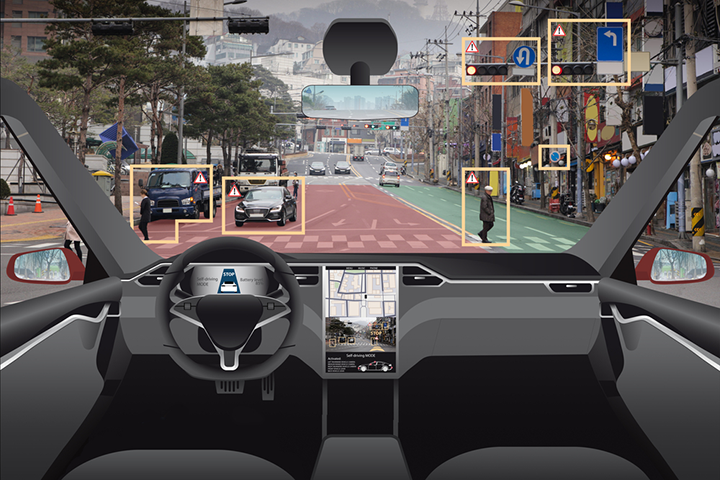Nuro Robotics Launches Driverless Grocery Delivery

A major breakthrough has occurred in driverless-vehicle technology. An autonomous vehicle is traveling city streets, not restricted to a specified route and with no safety driver onboard. It’s the Nuro robotics company’s R1, which was created for grocery delivery from the supermarket to the customer’s home or office.
In August 2018, Nuro launched a pilot grocery-delivery program with Kroger Co.-owned Fry’s Food Stores in Scottsdale, Arizona. At its end, in March 2019, more than 2,000 grocery orders were successfully delivered. Nuro is following its Scottsdale trial by partnering with two Houston Kroger stores to begin a delivery service in spring 2019. Houston customers are offered the service for $5.95 per delivery.
Founded in 2016 by former Google self-driving car project engineers Dave Ferguson and Jiajun Zhu, Nuro’s mission is “the production of a vehicle that is designed to be uniquely safe, leveraging the particular benefits of providing goods delivery to create innovations not possible with passenger vehicles. Because we provide last-mile delivery to homes and businesses, our vehicles will be routinely visible to the consumer and accountable directly to the communities in which they operate.”
Local last-mile driverless delivery a target
Ferguson says there’s a strong business case for local “last-mile delivery,” which is from the distribution center to the end user. People are busy and want convenience, and retailers are having problems meeting their expectations. The R1 was engineered to be flexible so it could meet delivery needs for pizzas, e-commerce packages, groceries and clothes from the dry cleaner.
Nuro reports that Americans make 220 billion vehicle trips a year, and more than 20 percent of those trips are to shop or run errands. Turning over errands to its service, Nuro says, will improve safety, expand economic opportunity, make home deliveries affordable, and reduce pollution and congestion.
Ferguson says a well-engineered driverless vehicle is much safer than human-operated automobiles, and keeping personal cars off the road decreases risks of accidents. “Over 90 percent of accidents are due to human error. Imagine if you had vehicles that never made mistakes, always paid attention, never tried to tweet while eating a Big Mac and drive at the same time.”
Nuro is starting its Houston service with added precautions, which at launch, don’t include the unmanned R1. “Initially we’re going to start delivering with our self-driving Prius vehicles,” Ferguson told Houston’s ABC TV news affiliate. “So, these are passenger vehicles just like regular Priuses that we’ve added sensing and computers to so they can drive themselves. There will still be safety drivers in them.”
Deleting the trip to and from the supermarket in personal cars with internal-combustion engines and letting the small electric-propelled R1 do the errands reduces pollution and congestion. Aside from running cleaner than the average car, the R1 is much smaller and less lane-crowding.
Measuring roughly half the length and width of a large SUV, the R1 benefits from greater clearance when navigating around obstacles and a few more feet of safety buffer to avoid collision. Weighing about half that of a typical car, its stopping distance is substantially shorter. The R1 operates at or below 25 miles per hour – a low speed that gives it more time to react and prevent collisions.
R1 cars are small, but come euipped with high tech
The R1 has an accurate 360-degree awareness of its changing surroundings via high-definition 3D maps to mark road features such as lane markings, curbs, traffic lights ad signs, crosswalks and speed bumps. Allowing it to precisely “see” the world around it are: lidar, which generates a precise 3D map of its environment; 12 high-definition cameras; radar; ultrasonic sensors; and audio sensors.
Consumers can summon Nuro grocery delivery with a food order online or using the Kroger app. It’s a process akin to ordering a pizza online. A time slot can be chosen for same-day or next-day pickup. A text message is sent notifying the customer when the order departs the store and the expected delivery time. Similar to waiting for an Uber or Lyft, the R1 can be tracked on route to the delivery location. A customer-service representative is available to answer questions by phone or through the vehicle’s touchscreen, which is similar to an iPad.
When the vehicle arrives curbside, the customer enters their special code on the touchscreen, which is located at the R1’s upper-center between two large doors. Only the door to the compartment where the customer’s groceries are stored opens. Once the groceries are removed, the R1 says “goodbye” and it drives off.
